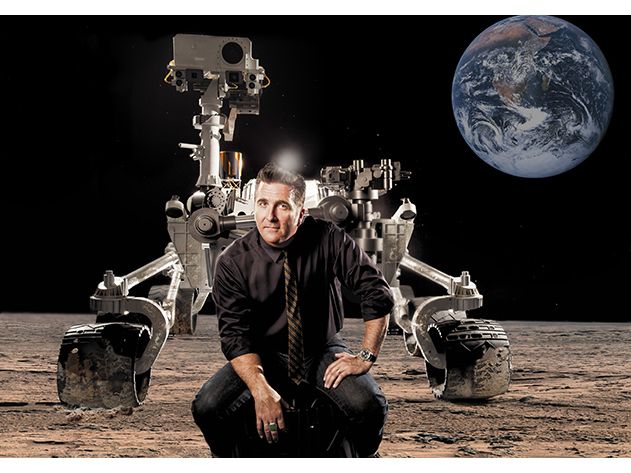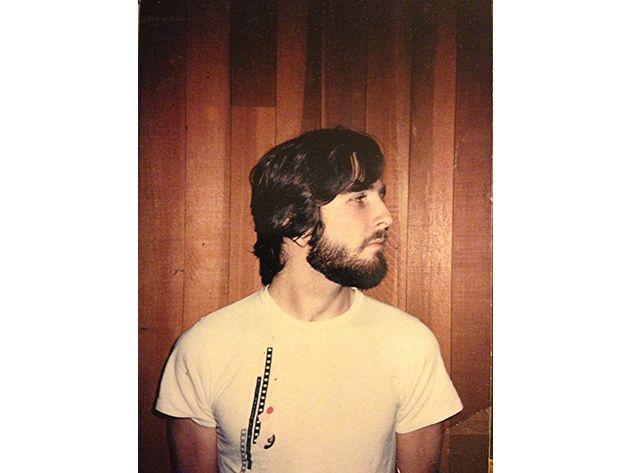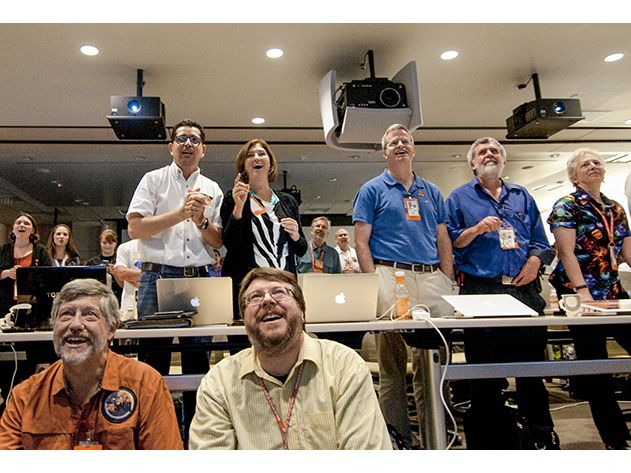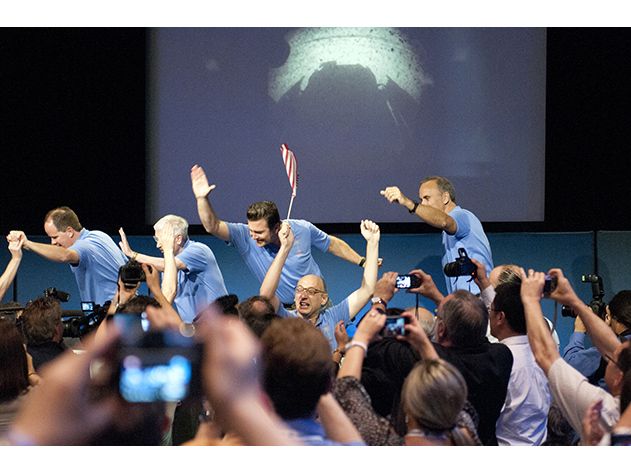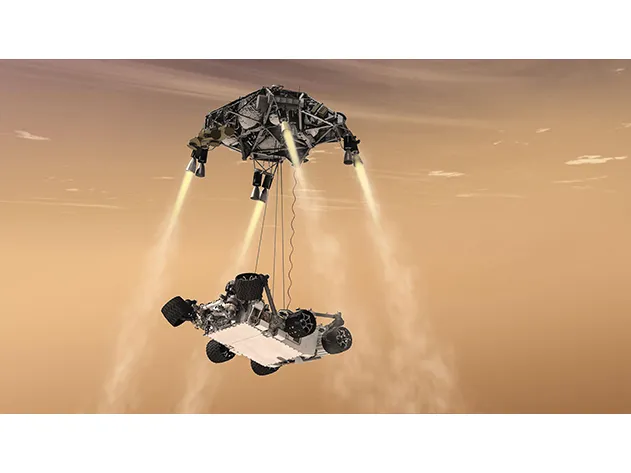The Brilliance Behind the Plan to Land Curiosity on Mars
Adam Steltzner’s ingenious ideas were crucial to the most spectacular space mission of our time
/https://tf-cmsv2-smithsonianmag-media.s3.amazonaws.com/filer/Steltzner-ingenuity-portrait-631.jpg)
In the days and hours leading up to the landing of the Curiosity rover on Mars, Adam Steltzner, a key figure behind that globally anticipated event, was often seen on TV explaining the physics of gently depositing a one-ton robot traveling at 13,200 miles per hour onto the planet’s rock-strewn surface. Curiosity was a $2.5 billion mission involving hundreds of scientists and engineers, but Steltzner became its public face, and much was made of his swashbuckling personal style, from the pomaded hair to the big belt buckles and snazzy cowboy boots—the fashion sense of the rock star he once aspired to be and a far cry, from a central casting point of view, from what folks had come to think of as standard NASA engineer regalia.
Then came the moment of truth. An intricate sequence of maneuvers conceived and choreographed by Steltzner’s team reduced the speed of the descending rover until it could be safely lowered to the ground via a hovering, rocket-powered contraption called a sky crane. Steltzner, like millions of other people across the planet, was glued to a monitor, watching nervously, though in his case what was at stake was the culmination of nine years of intense engineering work and not a little lobbying of NASA higher-ups to give his vision a shot.
“In the back of my mind I was waiting for something to go wrong,” Steltzner says. “I was rationally confident and emotionally terrified.”
He wasn’t alone. John Holdren, the White House’s science adviser, was reportedly so worried that he was almost physically ill. Mars is the Bermuda Triangle of space exploration. Only 15 of the 41 missions that human beings have sent to the Red Planet have been successful. In 1999, for instance, NASA’s Mars Climate Orbiter disintegrated in the atmosphere—a failure later attributed to an engineering mismatch between metric and English units of measurements.
Curiosity’s landing allowed for zero margin of error. And, because of the radio delay between Earth and Mars, the engineers were not able to control the spacecraft in real time. Instead, Curiosity would handle its descent autonomously—with each and every split-second maneuver dictated by more than 500,000 lines of computer code. NASA called the undertaking “seven minutes of terror.”
Steltzner recalls the white-knuckle experience to me one blazingly hot summer day at his home in Altadena, California, not far from his office at NASA’s Jet Propulsion Laboratory (JPL). Today his youngest daughter, Olive, is sick, and with his wife away, Steltzner, 50, is working from home and sporting a more casual look—T-shirt, shorts and sandals—though the rockabilly hair is still in evidence.
The successful landing of Curiosity in August 2012—after months of media speculation over whether the “crazy” plan would work—provided a much-needed dose of public exuberance at a time when it seemed as if the space program’s best days were behind it. “It proves that even the longest odds are no match for our unique blend of ingenuity and determination,” said President Barack Obama. Or, as Stephen Colbert declared, “We Mars’d it!” The rover is the largest, most sophisticated vehicle ever sent to another planet. With its 17 cameras, Curiosity has captured some of the most remarkably detailed images of Mars ever taken (including a selfie). And, equipped with a drill and a one million-watt laser, the rover is leaving no stone unturned (or unvaporized) as it studies the chemistry and geology of the planet. It has discovered an ancient streambed and chemical compounds—such as carbon, hydrogen and oxygen—that are necessary for life. Puttering along at 0.9 mph, the mobile laboratory will reach its primary destination next spring and slowly climb the foothills of Mount Sharp, a three-mile-high peak rich in clay sediments that could hold long-sought answers about the history of the planet’s climate.
And these dazzling historic science-and-engineering feats were made possible by a guy who failed high-school geometry.
***
Steltzner grew up in California’s Marin County, just north of San Francisco, a self-described child of privilege. “My parents didn’t work,” he says. “My father was the end of a line of decaying wealth inherited from the Schiller spice company.” Such a childhood has its benefits, but there is a dark side as well. “Inherited wealth,” says Steltzner, “means the past is always better than the future”—a psychologically bleak outlook for a child. He rebelled in the only sphere he could, stubbornly refusing to attend classes in high school, except for drama class and the associated theater program. During his senior year, he did just enough schoolwork to graduate, although he never bothered to pick up his high-school diploma.
His father threw up his hands and declared his son would never be more than a ditch digger. For the next few years, Steltzner did his best to prove him right. After a short-lived stint at Boston’s Berklee College of Music, he came back to the Bay Area, playing bass guitar in various local rock bands. Yet he felt restless and dissatisfied. He recognized a disturbing tendency in himself: He would find an activity he enjoyed, but the moment it became serious and required a commitment, his interest would flag. “I awoke to the fact that I had been trained to wait around for my dad to die and inherit money,” he says. “I didn’t like the idea of that. I was hungry for real meaning.”
He found his path one crisp fall night after a gig, while driving home over the Golden Gate Bridge—a route that provided a fine view of the Orion constellation. He noticed that Orion was not in the same place as it had been earlier in the evening, and decided to learn more about why stars move. He enrolled in an astronomy course at a local community college and took a conceptual physics course as a prerequisite.
Unlike his father, whom Steltzner describes as an intellectual dilettante inhabiting a dreamy world of abstract ideas, Steltzner has a pragmatic bent. He gravitated toward physics, with its tangible rules about how the universe works, and engineering, the application of those rules to real-world problems. “Here was bedrock,” Steltzner says, and he threw himself into studying physics, math and engineering with discipline and purpose he hadn’t known he possessed. “I became a monk to learn that shit,” he says, shaving his hair into a buzz cut and subsisting on brown rice. “I looked at this like the savior of my life.”
Steltzner earned a bachelor’s degree in engineering from the University of California, Davis, and a master’s in applied mechanics from Caltech in 1991. He got his first job by cold-calling JPL scientists until someone agreed to hire him in the spacecraft structures and dynamics group. Eventually he earned his PhD in engineering mechanics from the University of Wisconsin-Madison, working for JPL remotely during the academic year.
“When I first met Adam he reminded me of Elvis Presley,” says Gentry Lee, chief engineer of JPL’s solar system exploration program. He immediately pegged Steltzner as a kindred spirit, “one of those creative people who don’t want to be told what to do and don’t necessarily want to follow the rules.” Lee believes that the lab challenges Steltzner without squelching his creativity, or his personal style. “I think a long time ago somebody realized that if you want to have a place famous for doing one-of-a-kind engineering feats, you better make sure that you don’t corral your people too tightly or they won’t be able to get the job done.”
For his part, Steltzner relishes the fact that the laboratory fosters a culture that “reveres the truth. There are no sacred cows, there is no dogmatism.” While many engineers prefer to gain mastery in a specialized area and then stick with what they know, Steltzner prefers what he calls “the steep end of the learning curve.” He says he carved out a niche for himself as the guy who relished the technical tasks and problems that didn’t have much precedent: “People started saying, ‘That’s weird, let’s give that to Adam and see what he can do with it.’”
He also turned out to have a gift for leadership, able to see how all the pieces fit together into a whole. So Steltzner was chosen to head the mechanical engineering team to develop the entry, descent and landing (EDL) system for Curiosity—a challenge because the sheer size of the rover meant that the methods developed for previous missions wouldn’t work.
Steltzner and his team brainstormed for three days in 2003. Earlier that year, NASA had launched two other Mars rovers—Spirit and Opportunity—each weighing 400 pounds. JPL engineers had encased the rovers in air bags, enabling them to land by bouncing on the planet’s surface and then rolling to a stop to dissipate impact. But that approach wouldn’t work for Curiosity, which weighs five times more than Spirit or Opportunity. The requisite air bags would be too heavy and therefore too costly to launch. The impact would also kick up a lot of dust, compromising both the rover and its sensitive instrumentation.
Then Steltzner and his team looked at the approach that was being devised for the 700-pound Mars Phoenix Lander, which was launched in 2007 to study the north pole of the planet. Thruster rockets gradually lowered the vehicle to the surface on top of a three-legged lander. But with the larger, heavier Curiosity on top, a three-legged lander would be too unstable. And it would require more powerful rockets than Phoenix’s, which might create craters in the soil, making it difficult for the rover to drive away after landing.
Eventually, the team arrived at a solution: a sky crane. “You stay attached, come out together and do all your flying, and then just above the surface, when you are in perfect vertical flight, do the deployment,” says Steltzner.
The complexity of the landing sequence that the JPL engineers envisioned was unprecedented. First, the space capsule carrying Curiosity would eject its heat shield and deploy a supersonic parachute, which would slow its descent to 200 mph. Then an array of bolts would explode, releasing the chute and dropping the rover—attached to its landing gear—into freefall for a few seconds before firing rocket thrusters. The landing gear would hover at an altitude of 60 feet, while a crane lowered the rover to the surface using cables. After the rover landed, cable cutters would sever the link, allowing the crane to hurl itself away before crashing into the dusty Martian soil. Small wonder the code name for the EDL sequence was “Audacity.”
***
NASA had briefly considered a similar sky crane system (dubbed “rover on a rope”) for the 1997 Mars Pathfinder mission, but had shelved the idea because a tethered vehicle would have to contend with pendulum forces and wind shear on top of all the other problems. But when Curiosity’s EDL team did its analysis of the revamped design, “To our surprise the pendulum behaved,” says Miguel San Martin, chief engineer for guidance, navigation and control.
Still, there were other challenges. Given its larger size, the rover needed a soft touchdown, and this required a precise radar system to scan and map the terrain during descent. The EDL team tested the radar by mounting it on a helicopter—which, like the proposed lander, was capable of a slow descent and then hovering above the surface—in the middle of California’s Mojave Desert. That’s how they discovered that sand dunes could pose a problem for the delicate sensors in the radar system: The helicopter rotor whipped up grains of sand, much like the rover’s rocket boosters might do on Mars, creating a large error in the measurements. There was little they could do to change the design of the radar by then, but they were able to account for this effect in their calibrations.
Despite these precautions, it was impossible to test the entire landing sequence in advance. The only complete live experiment was the mission itself, monitored in the JPL control room from 352 million miles away.
First, Curiosity had to eject the final section of the rocket (the “cruise stage”) that had propelled it to Mars. At that point it needed to enter the planet’s atmosphere at just the right angle to avoid burning up. There was a harrowing nine-minute delay after the cruise stage separation before the first signal came back: Curiosity had arrived at the outskirts of the Martian atmosphere and was beginning its descent. Initially, the news was not good: “Beta out of bounds catastrophic.” (Translation: “Curiosity is tilting too much to the side.”)
After another agonizing four minutes, the next signal came in, indicating that all was normal. Curiosity had made it through the atmosphere.
Now the descent and landing sequence began. The parachute deployed, the heat shield separated and the radar system scanned the ground. Flight Dynamics and Operations Lead Allen Chen, who was broadcasting the play-by-play, announced the start of the sky crane sequence. “I am like, really?” Steltzner recalls. “Nine years and it’s just going to happen.”
Three crucial pieces of data needed to come in. First, the rover would send a message telling its creators back on Earth that it had landed safely. Next would be to confirm that Curiosity hadn’t landed on a crater wall or was being dragged along the surface by the still-connected descent stage. Finally, the descent stage had to fly off as planned, rather than landing on top of the rover and crushing its UHF antenna.
One by one, the messages came in.
“Tango delta nominal.”
“RIMU stable.”
“UHF good.”
On cue, Chen announced, “Touchdown confirmed,” as wild cheers broke out. The entire sequence had gone off with barely a hitch.
“Imagine running a race for nine years and you finally cross the finish line,” says Steltzner, who admits the aftermath has been a tough adjustment period for him. “How does my body stop running? I have been on an adrenaline drip for a decade. How do I live without the slow stress hormone release?” His solution: throw himself at the next steep learning curve. He has been assigned to a new mission, designing a vehicle capable not just of collecting samples on Mars, but packing those samples in hermetically sealed tubes and transporting them back to Earth. He’s also part of a possible mission to put a lander on Europa, one of Jupiter’s moons, which, with its methane oceans, icy surface and intense blasts of radiation, is even less hospitable than Mars. Both of those missions are in the earliest preliminary stages, however. “I think he’s still looking for his next great challenge,” says Lee.
Steltzner may be the public face of the Curiosity effort, but he is adamant that it was his entire team that pulled off the landing. “That is one of the beautiful things about engineering. It is a collaborative art,” he says. “We are only the product of what we do as a group.” He tried to prepare his team for the day when they would be disbanded. “I knew from my previous landing experiences that this beautiful community we had created was going to die that evening regardless of the outcome,” he says. "I told them to really love one another, to live in the moment and drink deep of the cup, because that guy you currently hate, hate the very sound of his voice–you are going to miss him."
